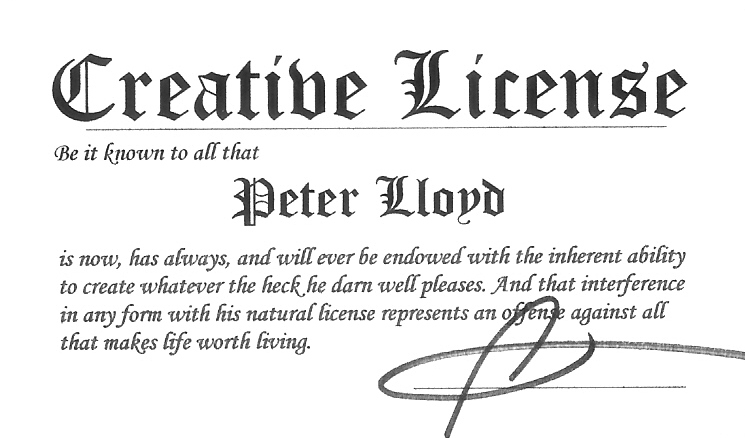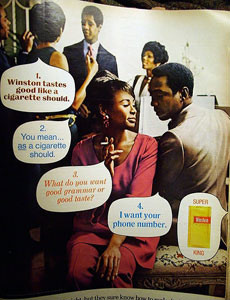Creative License
By Peter Lloyd"Be it known to all that Peter Lloyd is now, has always, and will ever be empowered with the inherent ability to create whatever the heck he darn well pleases. And that interference in any form with his natural license represents and offense against all that makes life worth living." That has been my idea and expression of Creative License ever since I understood the term.
 A few years ago I began to make real, paper certificates, suitable for framing with a companion, wallet-size version. I carry the wallet-size license with me at all times.
A few years ago I began to make real, paper certificates, suitable for framing with a companion, wallet-size version. I carry the wallet-size license with me at all times.Sometimes known as artistic license, dramatic license, poetic license (not to be confused with poetic justice), or narrative license, and so on, Creative License refers to a creator's freedom to ignore the conventions or rules that normally govern the art in which he or she works. It does not excuse shoddy work.
A lyricist, for example, might use the phrase "for you and I" instead of the correct form, "for you and me," in order to rhyme. A visual artist might distort a shape, change a color, or rearrange objects in a work in order to create a more pleasing or evocative image. A playwright or director might have an actor step toward the audience and speak his character's thoughts loud enough for other actors on the stage to hear, knowing that the audience will understand that the other characters on stage do not hear the spoken thoughts.
Creative License has been confused with permission to present shoddy work as artistic or creative. Bad grammar or misspelled words in a business memo do not fall under the protection of Creative License. The same goes for a work of creative fiction. The creator claiming Creative License must realize that he or she has broken a rule and then break it for a purpose that advances the objectives of the work. Anyone who claims Creative License, then, must first know the rules and how to obey them in order to break them.
 It's probably also a good idea to make sure your audience will appreciate your rule breaking if you choose to exercise Creative License. One of my English teachers used to rail against advertising slogans such as the historic, "Winston tastes good like a cigarette should."
It's probably also a good idea to make sure your audience will appreciate your rule breaking if you choose to exercise Creative License. One of my English teachers used to rail against advertising slogans such as the historic, "Winston tastes good like a cigarette should." The same teacher, who would lavishly praise Shakespeare's Creative License, had no appreciation for how less than trippingly off the tongue flies, "Winston tastes as good as a cigarette should taste"! Winston may have advanced the cause of Creative License but it sold my smoking English teacher no cigarets.
Creative License also runs the risk being confused with Creative Commons Licenses. Since late 200 Creative Commons has established several kinds of copyright licenses. In the new form of copyright the copyright owner generally grants more freedom to use the the copyrighted work.
See also:
Dave Dufour podcasts. Always entertaining and enlightened podcasts on the creative process under the title Creative License. They're all packed with helpful guidance and useful information. And since he's a pro at this sort of thing, you won't catch him abusing his Creative License.
The Creative License: Giving Yourself Permission to Be The Artist You Truly Are by Danny Gregory
Peter Lloyd is co-creator with Stephen Grossman of Animal Crackers, the breakthrough problem-solving tool designed to crack your toughest problems.
